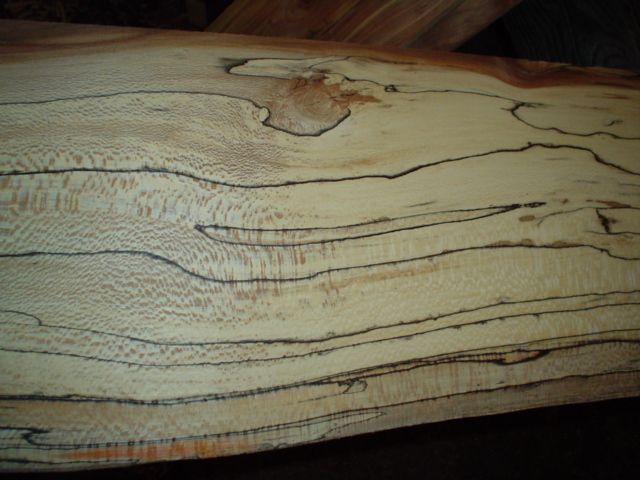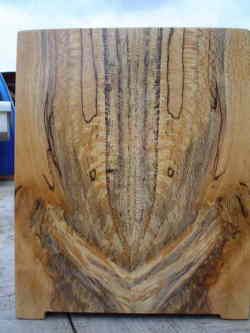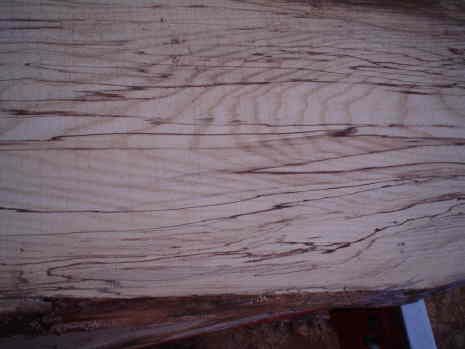How To Spalt Wood
Like making a world-class cheese, spalting wood intentionally is more art than science, and you may waste some raw material learning how. Here's an extended and detailed discussion. May 28, 2008
Question
I have often wondered how the process of spalting occurs, and if it is possible to cause a piece of wood to spalt. Does anyone know any tried and true methods for this? The wood I am particularly interested in working with is pecan, and I have heard that, for bowl blanks, you should put the piece in a trash bag full of that woods' shavings for a few months, and, voila! Has anyone tried this? That would be great for small things, but I would like to do actual lumber as well. I have semi-green logs (2-4 months old), green lumber air drying, and kiln dried lumber to work with.
Forum Responses
(Sawing and Drying forum)
From contributor J:
Why not try it? I have spalted many kinds of wood, no pecan yet. Old time turners suggest contact with earth, or old leaves. I have successfully spalted sweetgum bowl blanks by burying them in leaf piles in my yard. I have spalted the sapwood of black walnut and white oak. Since it is a fungal process, and one step toward total decay, you have to be careful to dry the wood and stop the spalting process.
From the original questioner:
I realize I may need to specify that I am particularly looking for information regarding spalting actual lumber. I know that using the bag method works, but an 8' long board is hard to bag up.
From contributor J:
You need to test the process - spalting is partial decay, caused by fungus. Bags are available in a variety of sizes, or you could use plastic and wrap it up.
From contributor D:
A board is best spalted not in a bag, but in the log. It takes moisture and heat. I don't think it is possible to spalt an already dry stick of lumber. Dry rot yes, spalt no. Maybe someone will jump in here and correct me? I say for proper spalting it needs to be left in the log, and the log rolled every few months (for more consistent color, just my experience.) I too have buried them in a pile of leaves. That was sort of a compost thing to keep the reaction from stopping too early in the fall. I have tried to spalt sweet gum blocks in a 5 gallon bucket with concoctions suggested to me... Never worked as well as just letting the log lay, then milling it. I got more white mold and dry rot than true spalt.
From contributor J:
I have successfully spalted sweetgum in the log - just let it lie in the yard for two years. I have also green turned sweetgum bowls and spalted them in piles of leaves - it only took a month or so, back when we used to get rain, and the bowls turned out great. I have had boards spalt after the following process - saw the logs into boards, stack them with stickers, leave the stack uncovered but in the shade for two years, and there you go - spalted maple, ash and oak boards.
From the original questioner:
I have several logs that have been sitting on the ground since last March and through about 30" of rain. I wonder if any of them have any results yet? I have rolled them around a time or two just because they got in my way, but I've never buried them in leaves. Should I?
From contributor D:
I am guessing if you are in "mesquite country," your spalt season is a little longer than mine. I just buried mine in leaves to generate heat/insulate and keep them cooking a little longer. My spalt pile is frozen solid right now and not doing anything, and won't till April. As far as if your logs are doing anything good, depends on what kind of logs. Sycamore, for example, will spalt pretty quick - in my area, that is a year. And just how spalted you want them - just discolored, or really distinct pencil line stock. One way to check is to cut a foot off the end of one and split it. I spalt here at the sawmill. Been doing it for years, mostly unsatisfactorily (too much room and time involved). I have had better luck finding truly fantastic stock by accident... Happen upon a pile of neglected logs someplace and "voila!" - to quote you - spalted lumber.
From contributor B:
I just cut some logs up that had been lying on the ground for about a year that was nicely spalted. I am thinking about using some of the spalted sawdust to cover new logs with thinking it will speed up the process. Possibly wrapping it with a tarp and wetting them real good.
From contributor T:
I have also spalted sweetgum, sycamore, and red box elder. I agree it has to be done in log form. I have some sycamore cooking right now. I could post a picture of it, but all I did was set aside about 6 saw logs on top of some ERC logs just to keep them off the ground by no more than a few inches. I have read where you should keep them off higher but I never do. I then let our native pasture grass grow up around the logs. That's all I do. It works.
Last year I did put some box elder in a large cardboard box in my shop that was already partially spalted. I only did it to set aside for some personal stash and did not give further spalting any thought. I opened the box to get some out this fall and the box was still very humid inside and a black widow had hatched hundreds of her little killers in there. As I retrieved the blocks of wood from the box, I have to say with about 95% assurance the spalting had continued, because they seemed at least to my memory quite noticeably more spalted than when they went in.
I suppose it could be just a bad recollection of how spalted they were in the first place, but I believe strongly that the spalting continued. I plan to tinker with this possibility some more in the future. If I am not dreaming and it did continue to spalt, I would guess the wood would have to already be spalting, and that simply placing green wood inside a cardboard box would not cause it to spalt. And no, I do not believe the black widows had anything to do with it
From contributor O:
I seem to recall this same discussion on this site a couple of years ago. One suggestion that was made was to place a green log in a large bale bag, normally used for large round hay bales. Mix up horse manure and some sawdust or shavings from some spalted wood. Add water to make it sloppy. Pour or brush into the log and bark. Remove most of the air from the bag with a vacuum. Leave in a warm location. The writer said this would speed up the process, as it maintained a moist environment for the fungus to grow. I have not tried this myself, can only assume it will work. It may also be a pile of horse $hit! I have had success cutting the log down, leaving it where it fell, covering the sides with a little dirt and leaves. Wait until you see small funguses growing on the ends. Or cut off a block and look.
From contributor A:
You mean like this?

Click here for higher quality, full size image
From the original questioner:
Yes, that's the idea. I actually got a bunch of pecan logs yesterday that were live trees but in several places they are highly spalted. How does that work?
From contributor A:
Spalt is mold in the wood. Most likely part of the tree was injured and the wood was dead in a live tree. Thus, given time, it spalted. Time is the key in spalting. I fell/buy logs March to May and then let them set for up to two years to spalt. I set them out in the woods in the shade to age. Too soon and not much spalt, too long and got soft junk that won't make good firewood. In the springtime you can saw and dead stack, leaving sawdust on the boards and adding beer sprayed between layers, then cover with a black plastic cover in the shade. In about 3 weeks, check. Pull it out too soon and you just have moldy boards, and too long and you have more soft junk. More art than science and you can waste a lot of lumber in the process. But when it is right, it is right. Like the bass?

From contributor S:
In the past, many have tried to get contributor A to surrender his super secret spalting formula but all have failed. Here he gives it up to you with no pleading, begging or groveling on your part! Must be that Southern sounding name.
From contributor A:
He is a southern boy and lives just southwest of me a bit in Texas terms. Malted beer from a warm can sprays best!
From the original questioner:
Thanks for the info. I have some logs that have been sitting in the sun waiting to be milled since March-April. Does shade make a whole lot of difference? I loved the picture of the bass. Pardon, but does that mean that was basswood? Or is that the type of creation it is?
Thank you for sharing your tips with me. At 18 years old, I'm still learning a lot, and am grateful to be able to learn from the pros. I can't get beer myself at this age, but maybe my dad can. I won't drink it, but now I know that it is good for something other than meddling with brains. As a non-expert on beer, what does "malted" mean? Also, do you have any tips on spalting bowl blanks? One other thing, do you think it would be wise to go ahead and cut up these logs I got the other day that are already spalted in some areas? If they aren't good for lumber, I suppose I could turn them into turning blanks.
From contributor J:
I have spalted rough turned bowls by burying them in leaves in the woods. The same might work for a bowl blank, but as with all spalting, you have to be careful to halt the process before spalt turns to rot.
From contributor F:
I have buried 4' diameter Western big leaf maple in sawdust for three years and had delightful success. Every board was nature's work of art.
From contributor V:
Just curious, how did you ever discover, or even think of the idea, to spray beer on wood to help it spalt. Not to insult, for it may actually work, but sounds like a crazy old timer's thing, like cutting trees down with phases of the moon.
From contributor A:
This is a Hackedberry I opened up this weekend. Turned out well. Only waited 7 months. But then here it spalts about the time it hits the ground in the summer. Malted beer has some malt in it. Choice is Colt 45 (no, not the pistol). It is best to get the logs just as the leaves are opening up in the spring.
The "bass" is a booked matched piece of spalted sickymore made into a piggybank.
Do not knock sawing or felling trees on the phases of the moon. I farm/hunt/fish/saw by the moon and have great success at all of them. My kin have been in these hills for generations with little education but have always kept food on the table. They done things for rhyme or reason, with no need to change what has worked for so long.

Click here for higher quality, full size image
From the original questioner:
Thanks. Will the logs be very spalted when I open them up before "beering" them for three weeks? What does the beer do to the wood visually? Thanks again for all the tips you've given me.
From contributor A:
It does no good to try to spalt wood below 70 degrees. You need to hold the log in log form till spring time and then saw. If spalt is light, then dead stack when sawing, trying to leave as much sawdust as possible on the boards. Spray some beer between layers, then cover and sit in the shade. Warm temps are key to this. Warning! You can ruin some wood doing this and as I said, it is as much art as science. You just have to keep messing with it and watching what you do and keeping track.


